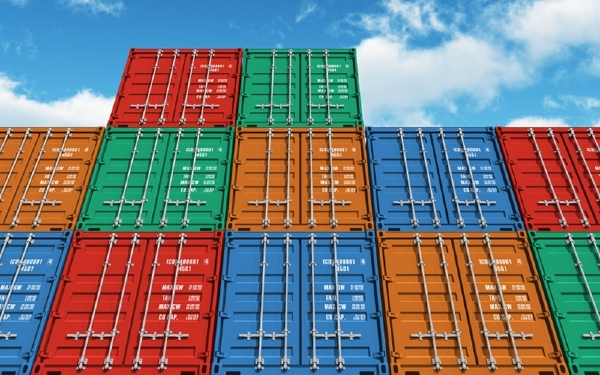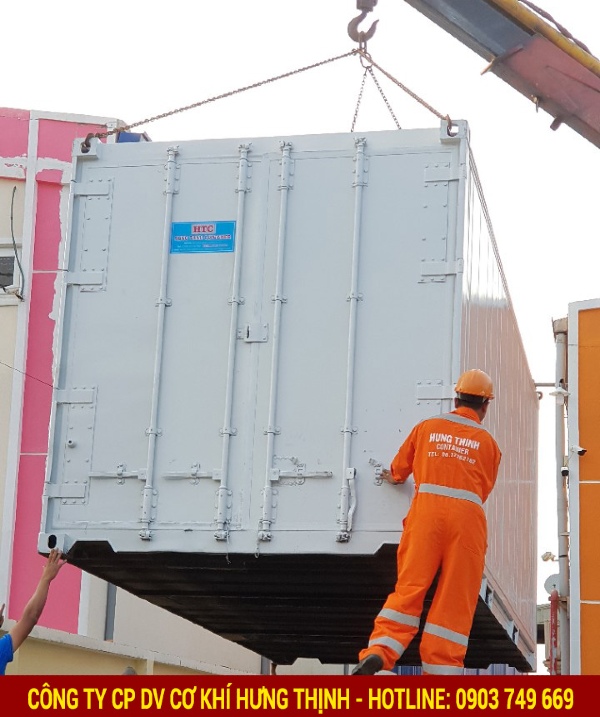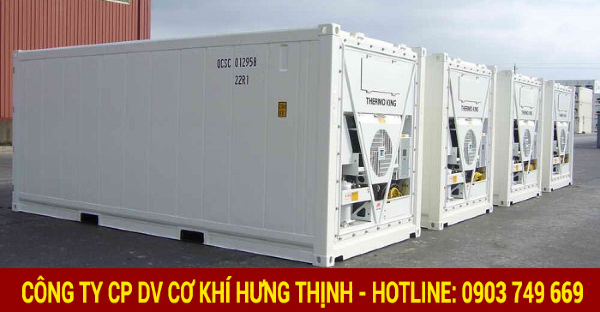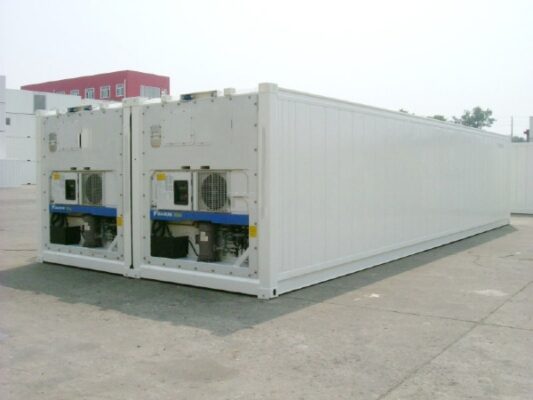Transportation and storage of goods are very important for manufacturing and processing enterprises. However, today there are many types and refrigerated container size different, making it difficult for businesses to choose. So, what is a cargo container? What is the size of each type? Find out details in the following article!
What is a cargo container?
A cargo container is an extremely useful tool used in transporting and preserving large quantities of goods and is widely used around the world. The word container comes from English and is understood in Vietnamese as a large box made of solid steel material, rectangular in shape. Containers are used to store and store goods and serve their transportation to predetermined locations.
Currently, many people confuse containers with tractors with large boxes on the back. In fact, these are two separate and detachable parts. The tractor has an engine, cockpit, license plate and performs the task of transporting containers.
Currently, containers handle up to 90% of the movement of goods worldwide.
>> Reference types of refrigerated containers provided by Hung Thinh Container here!

A cargo container is an extremely useful tool used in transporting and preserving large quantities of goods
1 foot, 1 inch is how many meters?
Normally, reefer container size will be calculated in international length units of feet or inches. However, in Vietnam, people often use the meter as a unit of length. This makes many businesses and investors quite confused in declaring the size of reefer containers when carrying out import-export and transportation cooperation procedures.
Feet (symbol ft, foot or single comma) is the most popular unit of measurement in the UK, US and around the world.
1 feet = 30.48cm.
Inches (print symbols or double commas) are also an international unit of length measurement similar to feet.
1 inch = 2.54cm.
Thanks to these conversions, businesses, investors or people in charge of declaring reefer container sizes, carrying out import-export procedures and transport cooperation are easier.

Feet and inches are international standard units of container length measurement
Classification of reefer container sizes
Refrigerated container sizes are currently divided into 5 main types: 10 feet, 20 feet, 40 feet, 45 feet and 50 feet.
Refrigerated containers, also known as insulated containers, are specialized for carrying items that require maintaining a certain temperature such as frozen, fresh foods and medical products.
Insulated containers are usually lined with a thick layer of insulation, and the floor is made of aluminum with a T-shaped structure that allows air to circulate evenly in the container, helping to maintain a stable temperature. Therefore, the size of the refrigerated container inside will be smaller than that of dry or general merchandise containers.
>> View now principle of refrigeration in containers Not everyone knows!
In addition, people also classify containers according to uses such as:
- General purpose container.
- Bulk containers (Bulk containers).
- Specialized container (Named cargo container).
- Open-top container.
- Platform container (Platform container).
- Tank containers (Tank containers).

10-foot refrigerated container at Hung Thinh Container
So, how are reefer container sizes classified, and what does the unit of measurement mean? Refer to the next content to learn more about the types of containers commonly used today!
Refrigerated container sizes and applications of each type
There are many sizes of reefer containers and other types that are also commonly used in the field of transportation and storage of goods today. Let’s find out specifically what those reefer container sizes are!
Refrigerated container size 10 feet
The size of a 10-foot refrigerated container is the smallest among current cargo shipping containers. Although very compact and easy to transport, this type of 10-foot container is rarely used because it cannot hold many goods. 10-foot refrigerated containers are often used as mini warehouses, field offices, restrooms or small houses.
| Parameter type | Feet | Meter | |
| Cover size | Lenght | 9ft 9.8in | 2.991 |
| Width | 8ft | 2.440 | |
| Height | 8ft 6in | 2.590 | |
| Inner size | Lenght | 9ft 3.3in | 2.828 |
| Width | 7ft 8.5in | 2.350 | |
| Height | 7ft 9.7in | 2.381 | |
| Door opening degree | Height | 7ft 6.2in | 2.291 |
| Width | 7ft 8in | 2.336 | |
| Volume | 16m³ | ||
| Empty container weight | 1350kg | ||
| Net load | 8810kg | ||
| Total load | 10160kg | ||
Refrigerated container size 10 feet
>> Reference 10-foot refrigerated container models at Hung Thinh Container right here!

The 10-foot refrigerated container is the smallest of today’s cargo shipping containers
Refrigerated container size 20 feet – RF
Inside the 20-foot refrigerated container, a specialized refrigeration system is designed and the temperature is maintained ranging from -18oC đến 18oC depending on goods preservation requirements. Refrigerated containers are often used to transport frozen items and fresh foods. The size of a 20-foot refrigerated container inside will be smaller than other types because of the thick insulation layer.
| Parameter type | Feet | Meter | |
| Cover size | Lenght | 20ft | 6.060 |
| Width | 8ft | 2.440 | |
| Height | 8ft 6in | 2.590 | |
| Inner size | Lenght | 17ft 11.9in | 5.485 |
| Width | 7ft 6in | 2.286 | |
| Height | 7ft 5.2in | 2.265 | |
| Door opening degree | Height | 7ft 3.6in | 2.224 |
| Width | 7ft 6in | 2.286 | |
| Volume | 28.4m³ | ||
| Thùng chứa số lượng trống | 3200kg | ||
| Load net | 27280kg | ||
| Total load | 30480kg | ||
Refrigerated container size 20 feet – RF
>> Refer to technical specifications and 20 foot container models at Hung Thinh Container!

The size of a 20-foot refrigerated container inside will be smaller than other types because of the thick insulation layer
Refrigerated container size 40 feet
The exterior dimensions of a 40-foot refrigerated container are the same as a regular 40-foot container. The only difference is that it is equipped with a cooling system and a cooling layer, so the internal design will be smaller than the regular 40-foot type.
Often used to transport fresh goods that need to maintain temperature: meat, seafood, fruits, vegetables,…
| Parameter type | Feet | Meter | |
| Cover size | Lenght | 40ft | 12.190 |
| Width | 8ft | 2.440 | |
| Height | 8ft 6in | 2.590 | |
| Inner size | Length | 37ft 11in | 11.558 |
| Width | 7ft 6.2in | 2.291 | |
| Height | 7ft 3.6in | 2.224 | |
| Door opening degree | Height | 7ft 2.2in | 2.191 |
| Width | 7ft 6.2in | 2.291 | |
| Volume | 58.92m³ | ||
| Empty container weight | 4110kg | ||
| Net load | 28390kg | ||
| Total load | 32500kg | ||
Refrigerated container size 40 feet – RF
>> Refer to sales – rental services 40 feet second hand container at Hung Thinh Container!

40 feet refrigerated container at Hung Thinh Container
Refrigerated container size is 45 feet
On the outside, a 45-foot container will be difficult to distinguish from a 40-foot container because there is not much difference in size. However, the type of 45-foot refrigerated container can be easily identified through the parameters written on the outside.
| Parameter type | Feet | Meter | |
| Cover size | Length | 45ft | 13.716 |
| Width | 8ft 2.4in | 2.500 | |
| Height | 9ft 6in | 2.896 | |
| Inner size | Lenght | 44ft 5.7in | 13.556 |
| Width | 8ft | 2.440 | |
| Height | 8ft 10.1in | 2.695 | |
| Door opening degree | Height | 8ft 5.8in | 2.585 |
| Width | 7ft 11.1in | 2.416 | |
| Volume | 86.1m³ | ||
| Empty container weight | 4800kg | ||
| Net load | 25680kg | ||
| Total load | 32480kg | ||
Refrigerated container size 45 feet – RF

The type of 45-foot refrigerated container can be easily identified through the parameters written on the outside
Kích thước container 50 feet
50-foot containers are larger in size than 45-foot containers and are quite few in Vietnam. Specific 50 foot container dimensions are as follows:
- Internal dimensions (length x width x height): 15,040 x 2,348 x 2,690 (m).
- Envelope dimensions (length x width x height): 15,240 x 2,438 x 2,896 (m).
>> Refer to the container trading services High quality, cheap price at Hung Thinh Container!
ISO standards for container size and tonnage
About the size of reefer containers
The numbers written on the surface of the container must meet ISO 668:1995 standards with a required width of 8ft (2,440m). The most standard container length is 40ft (12,190m). When stacking 40-foot containers at the port, there will usually be a gap of about 3in (7.6mm), creating favorable conditions for loading and unloading goods.

About the tonnage of the container
When arranging goods into containers, the person in charge should be careful not to let the volume exceed the net load limit mentioned in the article. This will help keep safety and convenience during the transportation and circulation of goods. The allowable load of the container is also clearly specified in the TCVN 6273:2003 prescribed by the Vietnam Register. Besides, the load also depends on the regulations of the shipping company, exporting country,…
Some notes to know about container size
Above are just the dimensions and reference parameters of previous container types. Because during the production process, it is up to the manufacturer to round the size of the container, so there will be a difference of a few cm or mm.
Container width according to ISO 668:1995 standard is 2,438m, or about 8 feet.
Previously, the standard height of a container was 8 feet, but later to adjust the appropriate size and accommodate more goods, the 8 foot 6 inch type was used instead and is the most used.
Do not rely too much on the net tonnage, and store goods close to the load parameters, because in reality the maximum threshold that can hold goods does not reach there, so you should consider when loading goods. go up.
Load capacity will be based on many different factors from shipping lines or according to State regulations. For example, the largest used load of a 20-foot container is 20.32 tons. But there will still be some shipping lines that have their own load regulations to ensure safety when moving goods, so you need to consider and ask the parties carefully.

Common problems encountered when choosing to buy, sell or rent containers
Many businesses will choose to buy new containers or have people rent containers to save costs, but during the buying process, many customers encounter the situation of buying or renting poor quality containers, affecting their business. economic resources of the enterprise. Below are problems that are easy to encounter when buying or renting containers
- The supplier delivers products that do not comply with the signed contract
- There is no warranty when purchasing containers
- Buying containers whose sizes do not match the intended needs and do not meet the required area.
- The raw materials produced on the container when purchased are not genuine, are poor quality goods, and are easily dented.
- The supplier did not transport the container to the correct location you wanted
- Container delivery and loading time is too long, too time-consuming.
Therefore, when buying or renting a container, you need to carefully check and observe the containers, size, materials or documents of the lessor to ensure our rights as well as your legitimate interests.
In this article, we provide you with information about the standard size, height, and tonnage of containers so that the buying or leasing process will be more effective.
Refrigerated containers bring many benefits in preserving and transporting items that require low temperature maintenance such as frozen foods, seafood, fresh meat or medical products. Besides, referring to refrigerated container sizes to have the right choice and arrangement according to the nature and quantity of goods also helps businesses save a lot of costs. At the same time, it provides great support in declaring information when carrying out export – import procedures and transport cooperation. Contact Hung Thinh Container immediately for advice and quotes on reefer containers as soon as possible!


